Veteran’s Testimony – Lena R. Gelott 48th Station Hospital

1st Lieutenant Lena R. Gelott Styles, 48th Station Hospital, ANC, N721595 (picture probably taken in New Zealand – when on DS with the 39th Gen Hosp – early 1944, wearing M1942 Summer Whites).
Introduction:
I was born and reared in rural West Peabody 8 April 1917, located approximately twenty miles north of Boston, Massachusetts. In 1920, the landscape consisted of many farms, and there were only eleven streets and about 20 different families living in our neighborhood, so everyone pretty much knew everyone else. I attended school at the old West school (located on Johnson Street) and took 8 years of Grammar School, 5 years of High School, and 3 years of College.
At the onset of World War 2, everyone who was eligible joined the various branches of the United States Army. Patriotism was strong, and everyone felt to be part of this great war effort, we were eager to serve (as a matter of fact my family contributed 3 of its members to serve the country, Frank (my brother) enlisted in the U.S. Navy; I entered the Army Nurse Corps and served my stint of duty in the South Pacific; Rachel (my sister) joined the U.S. Coast Guard. In total I would serve my country for a total of 3 years, 5 months, and 20 days, with the major part being overseas.
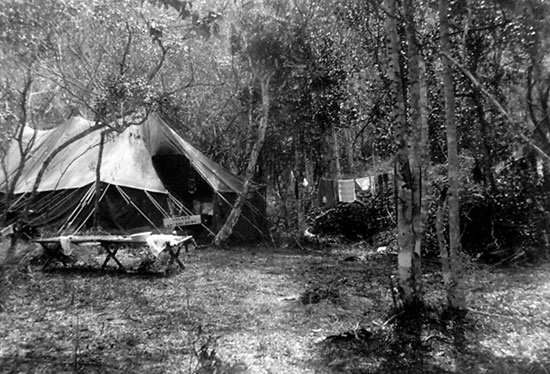
Grande Terre, New Caledonia, November 1942. Our first home in New Caledonia – a tent and a folding cot, rather primitive conditions.
“Greetings, the Army Nurse Corps needs and welcomes you!” That message greeted me on an island off the coast of Portland, Maine. The date, 3 August 1942, is one I remember well. With my luggage in the rumble seat of a car, I was off to face the greatest challenge and adventure of my life. As newly Registered Nurses when war was declared, my classmates and I felt duty bound to serve our great country. I had first applied to the Navy but got rejected (not tall enough). I had previously been rejected by 2 Training Hospitals before finally being accepted.
The Army Nurse Corps welcomed me. As the Nurses in my area had been sent to Africa, I thought I would spend a vacation in Maine and enjoy the ocean beach before receiving my orders to go there, but now I found myself reporting to Ft. Williams, Portland Head, Cape Elizabeth, Maine (former and permanent coast artillery fortification, later Headquarters Harbor and Coast Defenses of Portland). The next day I was assigned to Ft. McKinley (another permanent coast artillery station on Great Diamond island, located off the coast of Portland).
At that time, Army Nurses had no rank, they were given ‘relative’ rank equivalent to that of Second Lieutenant (but without the corresponding salary; in fact less than what I had earned as a civilian RN). We were issued Army clothes and full gear, including musette bag, gas mask, mess kit, bedroll, helmet, and flashlight. Ft. McKinley, Maine, was a beautiful introduction into Army life (except for the bad food).
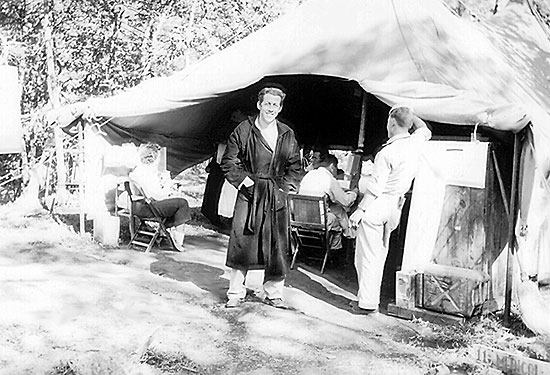
Partial view of our open-air Hospital Ward, New Caledonia.
Assignment:
My stay at Ft. McKinley was a short one. On 6 September 1942, I was assigned to the 48th Station Hospital, a 250-bed hospital unit and sent to San Francisco. Three Nurses from Ft. Williams, Maine, and myself received movement orders to report there (Dorothy M. Rushbrook, Josephine A. Scelsi, Doris A. Griffin), and on 24 September we entrained in Boston heading for the West Coast.
Special Orders No. 245 emanating from Headquarters First Service Command, Boston, Massachusetts, dated 6 September 1942 stated that the following Nurses, ANC, were released from their present station (effective 10 September 1942) and assigned to permanent duty with the unit indicated for overseas shipment. Orders were signed by Colonel Philip Hayes, GSC, Chief of Staff, Headquarters First Service Command.
|
ASSIGNED TO 48th STATION HOSPITAL From Ft. Williams, Portland Head, Maine |
|
| 2d Lt. DOROTHY M. RUSHBROOK | N 721511 |
| 2d Lt. JOSEPHINE A. SCELSI | N 721512 |
| 2d Lt. DORIS A. GRIFFIN | N 721534 |
| 2d Lt. LENA R. GELOTT | N 721595 |
|
ASSIGNED TO 48th STATION HOSPITAL From Westover Field, Chicopee Falls, Massachusetts |
|
| 2d Lt. ETHEL BARBER | N 721236 |
| 2d Lt. EUNICE E. BARRETT | N 721003 |
| 2d Lt. DOROTHY J. BROWN | N 721282 |
| 2d Lt. MARGARET M. FALLON | N 720332 |
| 2d Lt. GRACE M. GINNETTY | N 720181 |
| 2d Lt. RUTH T. GOOCH | N 721293 |
| 2d Lt. ROSLYN GROSS | N 721253 |
| 2d Lt. GLADYS M. LORD | N 721046 |
| 2d Lt. AGNES M. McCLUNG | N 720930 |
| 2d Lt. C. PATRICIA McDERMOTT | N 720938 |
|
ASSIGNED TO 48th STATION HOSPITAL From Grenier Field, Manchester, New Hampshire |
|
| 2d Lt. ALICE M. LaPLANTE | N 720992 |
| 2d Lt. JANETTE EDGECOME | N 720996 |
| 2d Lt. ELLA M. CURTIS | N 721022 |
| 2d Lt. MARCELLINE CONNOR |
N 721113 |
| 2d Lt. JEANNETTE PORTER | N 721214 |
We arrived in San Francisco on 28 September and by 0900 were at Ft. Ord, Monterey, California (Army Ground Forces Training Area & Landing Vehicle Board Headquarters), a huge place (28,690 acres) and one of the largest military bases ( troop capacity 51,253 EM) in California and on the West Coast where our unit was organized. The Nursing Staff consisted of 28 Nurses and 1 Chief Nurse. The other Nurses came from Ft. Custer, Battle Creek, Michigan (Military Police Replacement Training Center), while the Chief Nurse hailed from Texas, the 4 of us were the only New Englanders. The other Officers, Nurses, and Enlisted Men were from the Midwest. I joined the unit as a Surgical Nurse.
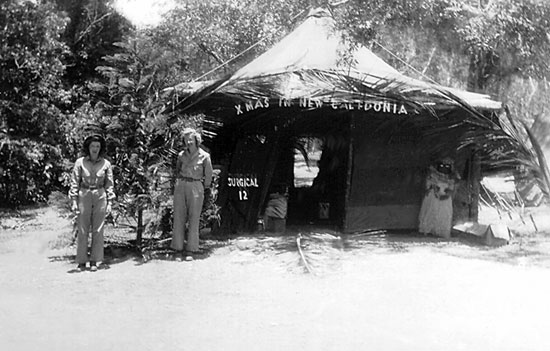
View of Surgical Ward “12”, New Caledonia. Picture taken around or after Christmas, December 1942. Both Nurses seem to be wearing Cotton Seersucker Slacks.
Basic Training:
On 6 October 1942, our unit left Ft. Ord for Cp. Stoneman, Pittsburg, California (Staging Area for San Francisco POE) where we were to receive our Basic Training.
Apart from the many marches, drills, and calisthenics, the use of the flamethrower came next. When it was my turn to use this heavy and hard to control weapon, disaster almost struck. In an attempt to keep it steady for aiming, I almost wiped out some of the watching medical staff. Before leaving Cp. Stoneman, we were given the necessary injections against smallpox, triple typhoid, and tetanus, followed later by vaccines against cholera, plague, typhus, and yellow fever… we got the lot.
Overseas Movement:
On 20 October 1942, the 48th Station Hospital boarded the USS Rochambeau (AP-63) for overseas. Our destination was not known, but we were the second contingent of US Army Nurses to head out across the Pacific packed in a convoy of 7 ships with 5 Hospital units on board!
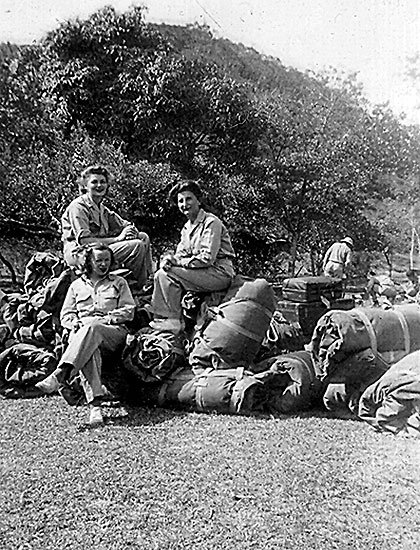
All packed for leaving! Nurses waiting to leave New Caledonia, picture taken early January 1943, prior to sailing for the New Hebrides.
The 48th STA HOSP was commanded by Colonel Lester R. WILSON, and our Chief Nurse was Georgia M. HAWKINS.
The ship (ex-French Maréchal Joffre) converted for use as a troop transport and casualty evacuation, left Oakland with troops, supplies and replacements for the Guadalcanal campaign. She made Nouméa, disembarked her medical cargo and passengers, picked up casualties, stopped at Suva and Bora-Bora, and returned to San Francisco by 3 December.
For the first week I was always seasick; we had 2 meals a day, regular salt-water showers, and were quartered 4 to a small stateroom. When crossing the equator, we had to undergo the official ritual when King “Neptune” ruled supreme. Life on board was not dull: calisthenics and abandon-ship-drills were almost routine, and sometimes a sailor with a guitar would entertain, and men would start singing.
First Station – New Caledonia:
As we neared our destination, we were told it was New Caledonia. On 27 November 1942, we entered Nouméa harbor, where we disembarked 3 days later. We were then herded like cattle onto two Army trucks to be taken to the 52d Evacuation Hospital where we would be located until our unit was organized and ready to head north. The roads were extremely bumpy and the ride most uncomfortable. We were located on the arid western side of the island, Grande Terre, and slept in a large tent adjacent to the ones occupied by the Nurses of the 31st Station Hospital. Our quarters now housed 3 Nurses to a small tent (Tent, Wall, Small) set on drier land (to avoid rainwater flowing through the tent). We were given a few days to acclimate and settle in before starting our duties. The Hospital wards were the large tents (Tent, Hospital Ward), their sides were rolled up, and chicken walked in and out every day. Lister bags were ready in front of each ward. What a change in conditions from Stateside Hospitals and starched white uniforms. We Nurses also had to adjust to living in primitive conditions; steel helmets had multiple uses, as a stool, as a washing tub, as a bathing tub, slacks and other clothes were hung on lines, blouses were wrinkled but clean, we even accepted the use of latrines. The girls of the 48th bonded so quickly, like sisters, we respected each other and shared everything. On our days off, we explored the island, the land was barren and dusty; when it rained, it was muddy, and mosquitoes came in droves.
Moving:
On 13 January 1943, the unit boarded the USAT Willard A. Holbrook (ex-President William H. Taft), and on the 14 of January, we set sail for Port Vila, the capital of Efate Island, in the New Hebrides. At the onset of the war, most French and British civilians had left for Australia.
The 48th Station Hospital was to be set up at the water’s edge in the midst of a coconut grove. Wooden buildings would house the O.R., central medical supply, and Nurses’ quarters. The wards would have wooden sides, with netting on the top half, and a tent roof. While the men were busy with the construction, we kept busy cutting and making medical supplies: sponges – bandages – abdominal pads – wrappers, all rubber goods were washed and sterilized. There were no disposable needles, syringes, or tubing at this time.
On 1 February 1943, the Hospital opened. Our first patient was Frances R. LAVALLEY, one of our Nurses, who fell off the boardwalk, and needed several sutures to close a severe cut on her leg.
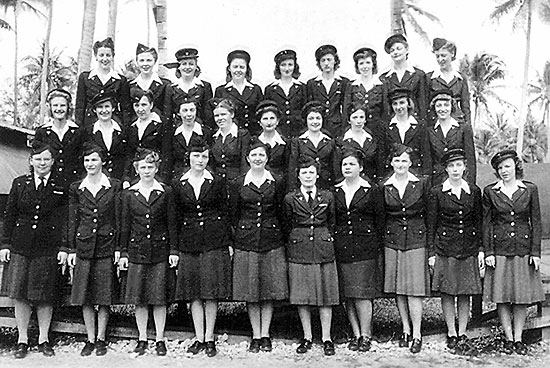
Efate Island, New Hebrides, January 1943. Official photograph illustrating the ANC complement of the 48th Station Hospital shortly after arrival (Nurses still wear the M1940 dark blue wool coat & blue wool skirt, white waist, visor hat, and black shoes. Indeed some Nurses going overseas received blue uniforms, due to the lack of new supplies, the change from blue to olive drab was only authorized 5 sep 42). 2d Lt. Anna M. Dybing (first person left, middle row). Identified by her son Rick Scruggs.
Patients were received from all the military units in the surrounding area and therefore additional wards had to be erected. Before we knew it we were confronted with severe injuries as well as malaria and dengue fever. When half the Nurses contracted malaria, the rest of us went on 12-hour shifts. Quinine was the only remedy and some Nurses could not tolerate it. After a while, my room-mate and I went to the water’s edge, rolled up our sleeves and pant-legs, hoping to get bitten, so that we could go on rest leave. We got practically chewed up, but we never got malaria. That was the end of our taking Atabrine tablets, which was a preventative for malaria. At the time, Nurses were not allowed to do IVs or draw blood for lab work, only a physician could do this. However, while a student Nurse, a doctor had bent the rules and taught me how to perform these procedures, and I did so in our makeshift hospital.
Rainy days off were footlocker days, and we would go through everything we packed and put it all back. Sometimes I returned to my ward and played checkers with a patient or wrote letters for one. There were no Red Cross volunteers yet to do such tasks. When we got 2 Red Cross workers, the Enlisted personnel wanted to know whether they were Officers or not, as EM were not permitted to date Officers. Meals were fairly good, considering the location, and we actually had fresh eggs for breakfast! We even cultivated a little garden growing tomatoes and peppers.
Our doctors were very considerate and pleasant to work with. They actually did listen to us, and often praised their own ward Nurses, while being at the Officers’ Club. The Corpsmen on our wards were excellent, though some had had no training before being assigned, but they were a great help both to us and to our patients. Curfew was 2330 daily, and we had to sign in at the gate before that time.
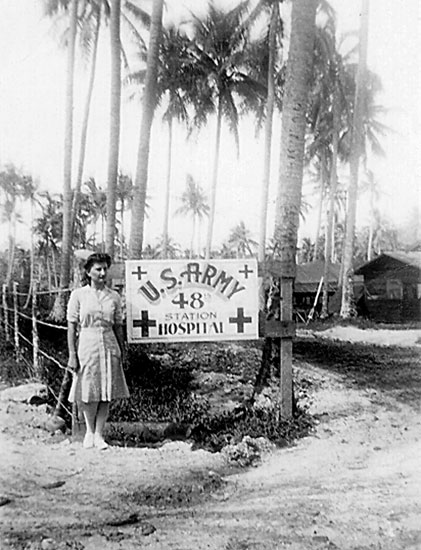
Port Vila, Efate Island, New Hebrides, February 1943. Official sign and entrance to the grounds of the 48th Station Hospital.
A few USO shows came to our island making us feel so grateful that we had not been forgotten, and Joe E. Brown, Jack Benny and Artie Shaw were very entertaining. Our most important visitor was First Lady Eleanor Roosevelt, who was making a 5-week tour of the South Pacific in 1943. She inspected our whole compound (this visit took place on 16 Sep 43) except the operating room where I was stationed. That really disappointed the other Nurse and myself since we had scrubbed it so thoroughly and desperately wanted to meet her. She addressed us all in the Detachment Mess Hall, speaking directly to the men, highly praising them for dedicating themselves to their country. We, Nurses, stood in the rear of the tent and were overlooked or not seen until our presence was brought to Mrs. Roosevelt’s attention.
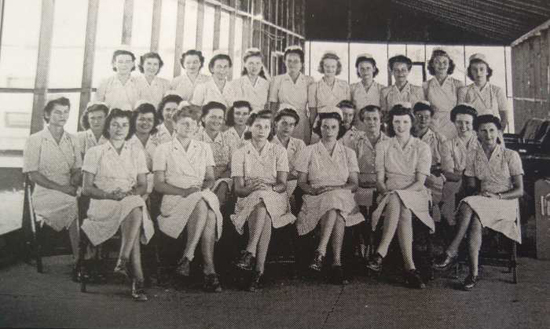
Guadalcanal, Solomons, July 1944. 2d Lt.Lena R. Gelott, ANC, N-721595 (first person left, first row), 2d Lt. Anna M. Dybing, ANC, N-731172 (fifth person from right, back row). Picture courtesy of Rick Scruggs.
Movies were shown at the ‘Open Air Theater’, with us sitting on benches, boxes, crates or chairs. One time, the show had a rainy scene and quite appropriately we watched it in the rain – we wore bathing suits under our raincoats so we were prepared not to get our clothes wet again.
Whenever invitations to dinner came from Army or Navy, we always decided Navy, for they had better food! Many ships stopped at the harbor during our stay on Efate, and we were often invited to go aboard such ships. One day we visited a submarine, and we made the mistake of wearing skirts. When the aircraft carrier escort USS Sangamon (CVE-26) visited, I was so excited as my brother-in-law was on board that ship. The Chief Nurse kindly arranged for us to visit each other, and we met again when the Navy Officers and Nurses invited the Army Nurses to dinner on board their ship. Again it was the food that was the greatest enjoyment of all.

2d Lt Lena R. Gelott pins the Purple Heart on one of her patients. Short ceremony held while the 48th Sta Hosp was still at Guadalcanal. Nurse Gelott wears the Cotton Seersucker Uniform and corresponding Cap (brown/white stripe wrap-around garment).
Two ARC Civilians were attached to our unit; they were Miss Lorraine S. Kernald and Miss Isabel Pick.
The Enlisted Men periodically printed a six-pages Newsletter called “The Aorta”, their staff consisted of 6 men and the news consisted of the happenings on the base.
On The Move Again:
Our men went north to establish another site for our Hospital. During the interim period, the Nurses were ordered to travel to New Zealand, where they would be attached to the 39th General Hospital, the Yale University unit (activated 15 July 1942, embarked for New Zealand 3 November 1942).
Special Orders No. 97, dated 21 December 1943, had been received from Headquarters Service Command, APO 932, signed by Captain William E. Thempleton, AGD, Adjutant General (on behalf of Colonel Passink), instructing a number of Nurses pertaining to the 48th Station Hospital to proceed from their station to APO 715, where they were to be placed on Detached Service with the 39th General Hospital. This involved the following ANC personnel:
| ASSIGNED TO 39th GENERAL HOSPITAL | |
| 1st Lt. Georgia M. HAWKINS | N 734128 |
| 1st Lt. Harriet J. JAYNE | N 730104 |
| 1st Lt. Anna A. PERRY | N 731147 |
| 1st Lt. Mary A. SULLIVAN | N 731274 |
| 2d Lt. Lillian C. ANDERSON | N 736527 |
| 2d Lt. Thalia A. CHAFFEE | N 739596 |
| 2d Lt. Irene CHRISTOFFERSEN | N 731141 |
| 2d Lt. Ethel V. CONFER | N 730747 |
| 2d Lt. S. Frances CRAFT | N 731179 |
| 2d Lt. Anna M. DYBING | N 731172 |
| 2d Lt. Lena R. GELOTT | N 721595 |
| 2d Lt. Doris A. GRIFFIN | N 721534 |
| 2d Lt. Alma L. GROOVER | N 731317 |
| 2d Lt. Virginia R. HAGGAN | N 730954 |
| 2d Lt. Julia E. HUNT | N 730895 |
| 2d Lt. Anne M. KAFKA | N 730396 |
| 2d Lt. Maxine F. KOLLER | N 743275 |
| 2d Lt. Frances R. LAVALLEY | N 730689 |
| 2d Lt. Mary M. MANGERIS | N 730703 |
| 2d Lt. Jane NICHOLS | N 731212 |
| 2d Lt. Rosemary N. REID | N 730586 |
| 2d Lt. Dorothy M. RUSHBROOK | N 721511 |
| 2d Lt. Ewalda C. SAMOLASKE | N 731308 |
| 2d Lt. Josephine A. SCELSI | N 721512 |
| 2d Lt. Betty A. STOUGHT | N 742241 |
| 2d Lt. Rhoda L. STOUT | N 730353 |
| 2d Lt. Mary C. USALIS | N 731189 |
| 2d Lt. Roma L. TOLVSTAD | N 731164 |
(some of the old gang, who joined the 48th Sta Hosp from Ft. Williams in Sep 42, accompanied me on this assignment, they were Nurses Rushbrook, Scelsi, and Griffin)
On 22 December 1943, it was 1500 hours, the Nurses of the 48th Sta Hosp departed on the USS Talamanca (AF-15), which was a re-supply ship making routine trips from Auckland (NZ) and various US bases in the South Pacific, for Espiritu Santo which was reached in the afternoon of the 24 of December. It was Christmas Eve, and we were ordered to attend a Navy party, but as we did not enjoy it, we left early. We left on Christmas morning, and on our way, stopped at New Caledonia. I had time to visit two Nurses of the 27th Station Hospital, whom I knew from home. We then left New Caledonia on the 29th and finally arrived in Auckland, New Zealand, on 31 December 1943. After disembarking and entrucking, we kept yelling at the driver to get back to the right side of the road, ignoring that New Zealand followed English tradition by driving at the left side of the road.
By 4 January 1944 we were on duty, gone were the striped wrap-arounds (Seersucker uniforms), and now we wore nice white uniforms. I was on duty at an orthopedic ward happy to be back working. One of our duties was censoring the EM’s outgoing mail. I hated invading a person’s privacy, and on reading some of the letters, we got really sentimental, and wanted to go home. The Hospital was located on One Tree Hill, the summit of an extinct volcano and offered a beautiful view of Auckland and the surrounding districts. Civilization meant having milk and decent food to eat.
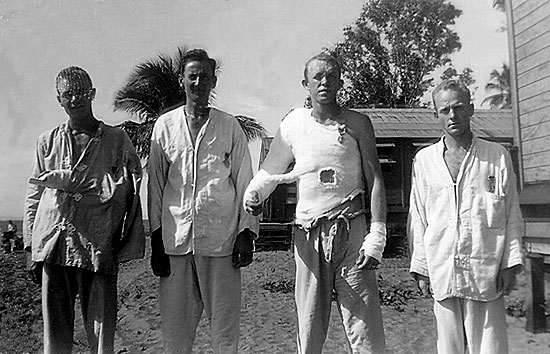
Guadalcanal, after awarding the Purple Heart to 4 of my patients (picture taken at the beach).
On 10 January, while walking on Queen Street, I ran into, of all people, my neighbor from West Peabody, Bruce Barr. I’ll never forget that! We were able to meet at the Hospital before his ship moved to another island. What a wonderful touch of home! While working at the 39th Gen Hosp, I was hospitalized and diagnosed with hookworm, and the cure was worse than the disease. After recovering, we attended concerts and plays. At Easter, I went to a solemn Pontifical Mass which attracted nearly 35,000 people. Lots of American personnel were present at this service. We paid a visit to an authentic Maori village, dined at elegant Hotels, and were invited and entertained by Army Air Force brass. We got invited to visit the Hot Geyser valley at Wairaka too, and tried fishing on Lake Taupo.
On To Guadalcanal:
Orders came to return to the islands. We had in fact hoped to go home, and when we found out, this was not to be, it was hard to say goodbye to friends and to civilization.
On 5 May 1944, after sitting three days on our bedrolls, we finally boarded the USS Talamanca. We stopped at New Caledonia on the 24th but could not leave the ship. Then it was on to Guadalcanal (campaign 7 Aug 42 > 9 Feb 43), in the Solomon Islands, where the temperature was the hottest. We were now 24 Nurses and a new Chief Nurse. On 28 May 1944, we were reunited with our unit (48th Sta Hosp), and on the 31st we were all back to work. It was so good to be welcomed back by our medics, who had performed the nursing care in our absence. They were very excited when they told us of a new drug being shipped over from the States called Penicillin!
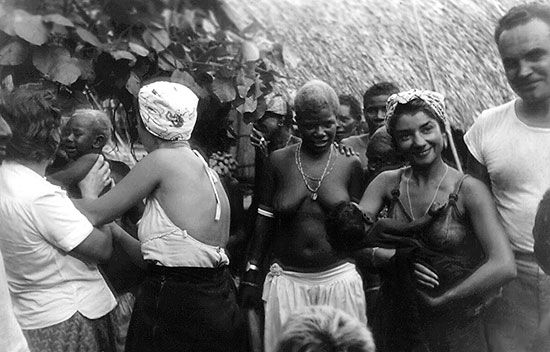
Guadalcanal, Solomon Islands, June-July 1944, during inland travel at a little village, meeting with natives and holding their babies …
There was no real chance to rest as casualties of the fighting began arriving by ship from Saipan and Leyte. We were very busy until all patients had been properly treated and evacuated. Then there would be a lull until the next group was admitted. I remember one poignant moment. As one patient was being wheeled into the O.R., he looked up at me, I smiled and gently touched his cheek. During his recovery, he mentioned how much that human touch meant to him. The patients were so young and so far away from family and home. Sometimes I forgot that we were young, too…
Mail call was all too infrequent and not enough letters came through. We yearned to hear from family and friends and to know what was going on in the States. We even wished for those small V-Mail letters. We were so isolated in this remote section of the world! The letters we wrote home were spotchecked and censored. We were not supposed to disclose anything of a military nature, such as our whereabouts, places, or destinations. One time my letter was checked, I had written that we were going to move to another island; and I received a warning to be more careful.
One day, we Nurses received a pleasant surprise when one of the pilots brought us a package. He was transporting supplies to our unit from home. The box contained dainty feminine apparel from a nameless benefactor in San Francisco. Whoever she was, she most certainly raised our morale, and we were truly grateful when our mysterious friend continued to send packages with this pilot whenever he came to our station. Finally we had a PX on the island, run by the Navy. The only items we could use were men’s T-shirts, but it was the idea of shopping and spending that we enjoyed most. It had been so long since we indulged in this simple female pleasure.
I felt honored when our C.O. (Col. Lester R. Wilson) walked into my ward with Purple Heart medals for 4 of my patients and asked me to present them to the men. I thought they deserved better recognition for their bravery so I asked them to step out on the beach. As there was no one else to observe I asked a fellow-Nurse to join us. The 4 men stood in line for this little ceremony and I pinned the medals on their pajamas, except one I had to pin onto a cast. We congratulated our ‘heroes’ and took their picture.
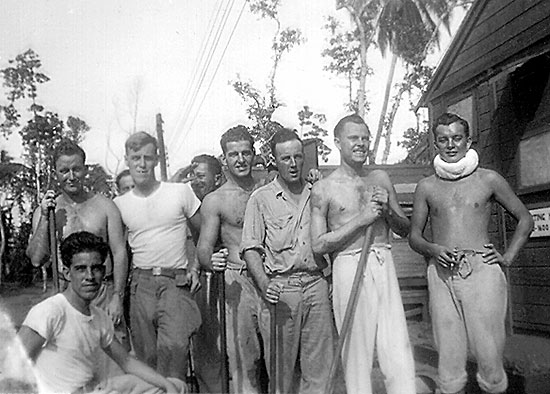
Guadalcanal, some of the ambulatory patients grouped as a temporary ‘cleaning crew’ to tidy up the place …
It was very hot on the island, so hot that our thermometers could no more record the temperature. A high barbed fence enclosed our quarters and a guard was stationed at the gate day and night. We had a smaller building for laundry which contained a huge double soapstone sink. What a delight it proved to be; we covered the windows with towels and then soaked in the sink and played cribbage. We managed to balance the board on the sink divider. Each morning at breakfast we were supposed to take 2 salt tablets. The first morning I took them as instructed and headed down the boardwalk to my ward. Then suddenly I became very nauseated and threw up my salt tablets along with my breakfast. I felt so much better afterwards that I went back and had another breakfast (minus the salt tablets). After that episode, I refused to take anymore salt tablets.
There were apparently still some Jap snipers on Guadalcanal, and one prowler did penetrate our enclosure. Luckily he was apprehended before he was able to enter our building. We had all been waiting in the central room and were waiting for him – 25 women against 1 man!
Our quarters were right on the beach, and from there we looked out at the islands Savo and Tulagi, which US forces had secured. The Guadalcanal campaign in fact marked our first actual offensive operations in the South Pacific theater. Marines and Seabees were active on the island, and hulks of sunken Japanese ships with multiple debris were gruesome reminders of war.
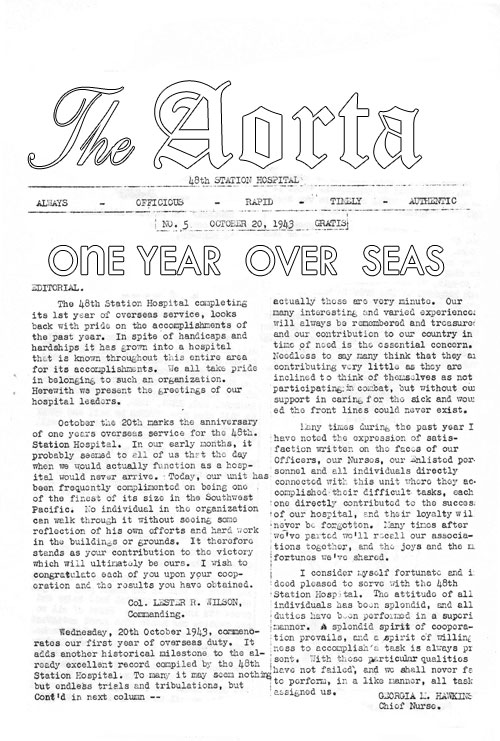
Front page of “The Aorta” – No. 5 October 20, 1943, gratis 6-page newsletter published by a staff of six EM. Its title meant A > Always, O > Officious, R > Rapid, T > Timely, A > Authentic. Nurse Gelott has her own explanation: A – Always will this paper endeavor to satisfy, O – Obliging, dutiful, and absolutely unofficial, R – Rapid and swift in thought and action, T – Timely, the right quip at the right moment, A – Authentic if rumors are to be believed …
Please note that the authors have been forced to re-design the header of this item, since the original was largely illegible.
We were happy when a Catholic Chaplain, Father Bernard Burgert joined our unit. He became a good friend to us as well as our spiritual adviser. Hymns were now being sung at Mass, as we now had a choir of 5 Nurses and 2 soldiers for the Christmas Midnight Mass. We decorated the wards, visited each one, and sang Christmas Carols. The patients even joined us. One of the wounded, a Lieutenant I knew, asked me for a bottle of Coke, I poured about an ounce, refilled the rest of the bottle with Bourbon, and handed it to him, walking away without looking back. I wonder what his expression was when he took that first sip, I am sure he must have been very pleased.
During our stay on the island, one of our Nurses, Anna M. Dybing, got married to Richard Scruggs (B-25 pilot assigned to the 42d BG) on 13 December 1944. What a happy occasion; the bride looked lovely in a borrowed white dress and shoes while carrying a bouquet of tropical flowers.
Another Destination:

1st Lieutenant Anna M. Dybing, ANC (N-731172) 48th Station Hospital, and 1st Lieutenant Richard H. Scruggs, Thirteenth Army Air Force (O-675375) 42d Bombardment Group, were married on Guadalcanal 13 December 1944. The ceremony took place in the Station Chapel with Reverend Clarence Johnson officiating. The bride wore a long white wedding gown with a headdress of lace, handmade by the Nurses. The photo shows the bridegroom’s best man (Maj. Linberg) and the bride’s maid of honor (Lt. Koller).
Photo courtesy of Rick Scruggs (their son).
On 3 March 1945, we boarded the USS Elizabeth C. Stanton (AP-69) bound for another destination (not home though). I do remember that on this voyage the seas were very rough and I got very seasick. Our rooms consisted of tiers of three bunks, totaling 9 bunks to a room. It was too hot to sleep, so I took my mattress from the top bunk and slept on the floor of our small bathroom. About a week later around 9 or 10 March 1945 we reached Eniwetok (campaign 17 Feb 44 > 23 Feb 44) in the Marshall Islands. We were able to get off the ship and enjoy swimming at a beautiful beach. We met personnel pertaining to the 232d General Hospital, fresh from the States, and waiting to go to Saipan.
More Traveling:
We were underway again on 17 March arriving in Guam (campaign 21 Jul 44 > 10 Aug 44) on 21 March 1945 where we spent several days. For 2 days we were allowed to go ashore. We finally reached Tinian (campaign 24 Jul 44 > 1 Aug 44) on 26 March 1945. General conditions on this island were better than the others except for the persistent red dust. We were set up on a cliff next to a B-29 Superfortress Wing, (313th Bomb Wing, 6th Bomb Group, 20th Air Force) which was located below us. We watched the planes take off daily for Japan and used to count them on their return. Once 2 of us drove down the strip with the Chaplain while he stopped at each aircraft before it took off. The Chaplain gave his blessings and we gave the crew candy bars. We received many offers of a ride to Japan. We officially began our duties on 12 April 1945, and were attached to the 374th General Hospital. Our Nurses were kept very busy with many casualties coming in from Okinawa. Besides nursing care, I shaved my patients, and cut their long hair. On the Bulletin Board in my ward, I would list a number of duties for the ambulatory patients to perform, such as filling water pitchers, sweeping floors, emptying waste baskets, etc. That worked well as long as I had an Enlisted Men’s ward. Now that I had an Officers’ ward, I was a little apprehensive of their cooperation. However, I decided to put up a list anyway. I listed last names only (no ranks) and asked the only Navy patient to begin his chore, hoping the others needed no inducement. I was happy when I saw all patients encouraging and helping each other whenever they could. We were all one family trying to make the best of things, and it worked!
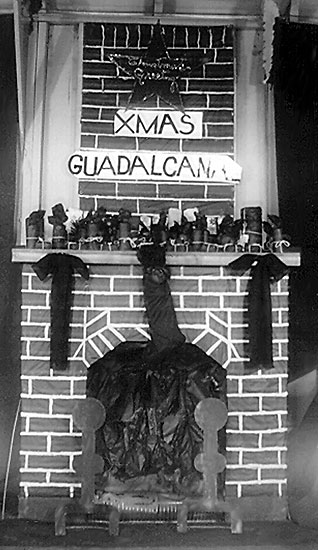
Guadalcanal station, makeshift Christmas decoration in preparation for 25 December 1944.
One of my patients had received severe injuries to his right hand. While changing dressings, I asked what he did for work back home. He replied “I’m a surgeon”, and then added that he would have to find another job, as he knew he would never recover full dexterity of his hand. Such are the tragedies of war.
We had a Japanese patient on my ward, he was put up in a private section, restrained and well guarded. Only male personnel were allowed to care for him, but I was permitted to see him from time to time. I couldn’t help thinking that he was just another scared young soldier.
Seabees on the island were busy with construction jobs and I asked for some lumber to build a little bedside table for my cot.
The girls who performed in the USO shows slept in our quarters and were given 2 mattresses for their cots, while we had none. One day, when they were out, the taller girls of our unit tried on their dresses. The USO girls returned unexpectedly, but definitely understood our longing to try on civilian clothes.
One night, B-29 bombers were returning from a bombing run over Japan, and they mistook our lighted boardwalk for the runway, which was just below us. They came down rather low, and the sound was so terrifying that the patients scrambled out of their cots and tried to hide under them. The other Nurses and myself ran out with flashlights waving and yelling like mad. We kept flashing our lights in the direction of the runway, and luckily, the pilots realized their error and the planes swept upward. The one that flew over my ward just barely missed the nearby treetop. I can still see its huge belly as it swerved skyward. It took a while to calm our patients … and ourselves.
In July, I became eligible for a 45-day leave to the United States, and was longing to return to my family, my home, and civilization. 4 of our Nurses had already gone home and had returned. I left Tinian at 0930 hours, 16 July 1945 along with 3 other girls. We made a stop – over at Guam (2 days), then went on to Kwajalein (campaign 31 Jan 44 > 3 Feb 44). The next stop was Johnston Island (southwest of Hawaii). We traveled in small aircraft and ate box lunches about every three hours. On 19 July we landed on Oahu, Hawaii, where we stayed for a few days enjoying the rest and the sights. We left Oahu on 22 July arriving at Hamilton Field (AAF Airbase & Training Center), California, USA, 23 July 1945. Two days later I was boarding a train in Oakland to go cross-country.
My official leave was scheduled to be from 1 August to 15 September 1945, when I was to report back to Tinian. However, the dropping of the A-bomb on Japan signaled the end of the war in the Pacific and duly changed my orders! Meeting my parents and the rest of the family once again (after serving more than 3 years overseas) brought me feelings that I cannot adequately describe.
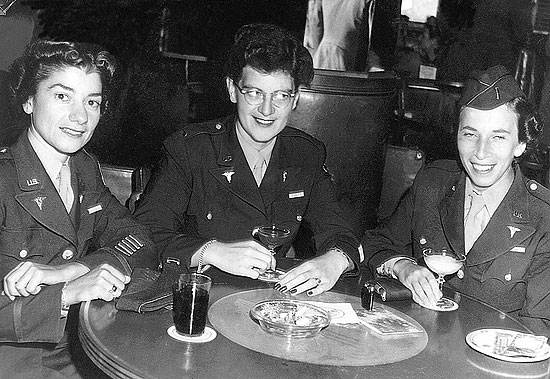
Back home in San Francisco, July 1945. From L to R: Nurses Lena R. Gelott, Harriet Johnson, and Jo Scelsi (Service Uniforms are now the olive drab wool version).
I reported to Ft. Devens, Ayer, Massachusetts and then on 2 September 1945 I was sent to Ft. Dix, Wrightstown, New Jersey (Training and Pre-Staging Center & Separation Center) for processing. After a five-day delay, and with an ASR score of 70 points, actual processing started and I was admitted as a patient with severe arthritis in my right ankle. I couldn’t walk so I asked Jo (Josephine A. Scelsi, a fellow-Nurse, on leave with me) to sign my name on the Discharge papers. With a bandaged ankle, and a bandaged eye (removal of a cinder during my last trainride), I was Honorably Discharged from the US Army on 13 January 1946, as a member of the 374th General Hospital.
All the men we had met – our patients, our Officers, our Enlisted Men, and our friends, all of them treated us girls with great respect and helped us in any way that they could. All of us Nurses performed our duties with the supporting forces back home… I shall therefore always treasure my memories of serving my country in World War 2 and of meeting people from all parts of the world.
Above excerpts were taken from the booklet “World War II Memories South Pacific” written in 2002 by 1st Lt. Lee R. Gelott, ANC (N-721595) who served as a Nurse with the 48th Station Hospital in WW2. We are truly indebted to this ANC Veteran for sharing her personal reminiscences and pictures with our staff.
